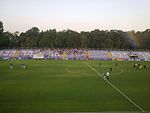Ramat Gan National Park
Parks in IsraelRamat GanTourist attractions in Tel Aviv DistrictUrban public parks

Ramat Gan National Park (Hebrew: הפארק הלאומי, HaPark HaLe'umi) is a large urban park in the Tel Aviv District city of Ramat Gan, Israel. It is not actually a national park.
Excerpt from the Wikipedia article Ramat Gan National Park (License: CC BY-SA 3.0, Authors, Images).Ramat Gan National Park
Ahad HaAm,
Geographical coordinates (GPS) Address External links Nearby Places Show on map
Geographical coordinates (GPS)
| Latitude | Longitude |
|---|---|
| N 32.049225 ° | E 34.825802777778 ° |
Address
הפארק הלאומי
Ahad HaAm 3
5223403 , Ramat Shikma
Tel Aviv District, Israel
Open on Google Maps










